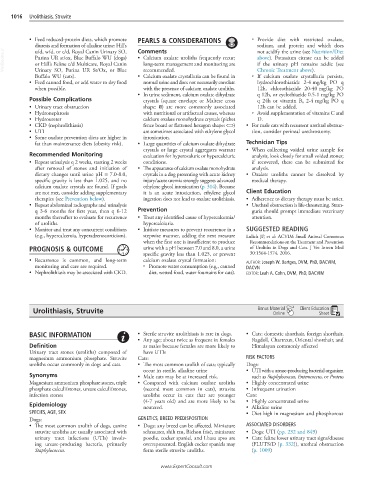Page 2034 - Cote clinical veterinary advisor dogs and cats 4th
P. 2034
1016 Urolithiasis, Struvite
• Feed reduced-protein diets, which promote PEARLS & CONSIDERATIONS ○ Provide diet with restricted oxalate,
diuresis and formation of alkaline urine: Hill’s Comments sodium, and protein and which does
VetBooks.ir Purina UR st/ox, Blue Buffalo WU (dogs) • Calcium oxalate uroliths frequently recur; above). Potassium citrate can be added
u/d, w/d, or c/d, Royal Canin Urinary SO,
not acidify the urine (see Nutrition/Diet
if the urinary pH remains acidic (see
long-term management and monitoring are
or Hill’s Feline c/d Multicare, Royal Canin
Chronic Treatment above).
recommended.
Urinary SO, Purina UR St/Ox, or Blue
Buffalo WU (cats). • Calcium oxalate crystalluria can be found in ○ If calcium oxalate crystalluria persists,
• Feed canned food, or add water to dry food normal urine and does not necessarily correlate hydrochlorothiazide 2-4 mg/kg PO q
when possible. with the presence of calcium oxalate uroliths. 12h, chlorothiazide 20-40 mg/kg PO
• In urine sediment, calcium oxalate dihydrate q 12h, or cyclothiazide 0.5-1 mg/kg PO
Possible Complications crystals (square envelope or Maltese cross q 24h or vitamin B 6 2-4 mg/kg PO q
• Urinary tract obstruction shape: ) are more commonly associated 12h can be added.
• Hydronephrosis with nutritional or artifactual causes, whereas ○ Avoid supplementation of vitamins C and
• Hydroureter calcium oxalate monohydrate crystals (picket D.
• CKD (nephrolithiasis) fence board or flattened hexagon shape: ) • For male cats with recurrent urethral obstruc-
• UTI are sometimes associated with ethylene glycol tion, consider perineal urethrostomy.
• Some oxalate prevention diets are higher in intoxication.
fat than maintenance diets (obesity risk). • Large quantities of calcium oxalate dihydrate Technician Tips
crystals or large crystal aggregates warrant • When collecting voided urine sample for
Recommended Monitoring evaluation for hyperoxaluric or hypercalciuric analysis, look closely for small voided stones;
• Repeat urinalysis q 2 weeks, starting 2 weeks conditions. if recovered, these can be submitted for
after removal of stones and initiation of • The appearance of calcium oxalate monohydrate analysis.
dietary changes until urine pH = 7.0-8.0, crystals in a dog presenting with acute kidney • Oxalate uroliths cannot be dissolved by
specific gravity is less than 1.025, and no injury/acute uremia strongly suggests advanced medical therapy.
calcium oxalate crystals are found. If goals ethylene glycol intoxication (p. 314). Because
are not met, consider adding supplementary it is an acute intoxication, ethylene glycol Client Education
therapies (see Prevention below). ingestion does not lead to oxalate urolithiasis. • Adherence to dietary therapy must be strict.
• Repeat abdominal radiographs and urinalysis • Urethral obstruction is life-threatening. Stran-
q 3-6 months for first year, then q 6-12 Prevention guria should prompt immediate veterinary
months thereafter to evaluate for recurrence • Treat any identified cause of hypercalcemia/ attention.
of uroliths. hypercalciuria.
• Monitor and treat any concurrent conditions • Initiate measures to prevent recurrence in a SUGGESTED READING
(e.g., hypercalcemia, hyperadrenocorticism). stepwise manner, adding the next measure Lulich JP, et al: ACVIM Small Animal Consensus
when the first one is insufficient to produce Recommendations on the Treatment and Prevention
PROGNOSIS & OUTCOME urine with a pH between 7.0 and 8.0, a urine of Uroliths in Dogs and Cats. J Vet Intern Med
specific gravity less than 1.025, or prevent 30:1564-1574, 2016.
• Recurrence is common, and long-term calcium oxalate crystal formation: AUTHOR: Joseph W. Bartges, DVM, PhD, DACVIM,
monitoring and care are required. ○ Promote water consumption (e.g., canned DACVN
• Nephrolithiasis may be associated with CKD. diet, wetted food, water fountains for cats). EDITOR: Leah A. Cohn, DVM, PhD, DACVIM
Urolithiasis, Struvite Bonus Material Client Education
Sheet
Online
BASIC INFORMATION • Sterile struvite urolithiasis is rare in dogs. • Cats: domestic shorthair, foreign shorthair,
• Any age; about twice as frequent in females Ragdoll, Chartreux, Oriental shorthair, and
Definition as males because females are more likely to Himalayan commonly affected
Urinary tract stones (uroliths) composed of have UTIs
magnesium ammonium phosphate. Struvite Cats: RISK FACTORS
uroliths occur commonly in dogs and cats. • The most common urolith of cats; typically Dogs:
occur in sterile, alkaline urine • UTI with a urease-producing bacterial organism
Synonyms • Male cats may be at increased risk. such as Staphylococcus, Enterococcus, or Proteus
Magnesium ammonium phosphate stones, triple • Compared with calcium oxalate uroliths • Highly concentrated urine
phosphate calculi/stones, urease calculi/stones, (second most common in cats), struvite • Infrequent urination
infection stones uroliths occur in cats that are younger Cats:
(4-7 years old) and are more likely to be • Highly concentrated urine
Epidemiology neutered. • Alkaline urine
SPECIES, AGE, SEX • Diet high in magnesium and phosphorous
Dogs: GENETICS, BREED PREDISPOSITION
• The most common urolith of dogs, canine • Dogs: any breed can be affected. Miniature ASSOCIATED DISORDERS
struvite uroliths are usually associated with schnauzer, shih tzu, Bichon frisé, miniature • Dogs: UTI (pp. 232 and 849)
urinary tract infections (UTIs) involv- poodle, cocker spaniel, and Lhasa apso are • Cats: feline lower urinary tract signs/disease
ing urease-producing bacteria, primarily overrepresented. English cocker spaniels may (FLUTS/D [p. 332]), urethral obstruction
Staphylococcus. form sterile struvite uroliths. (p. 1009)
www.ExpertConsult.com

